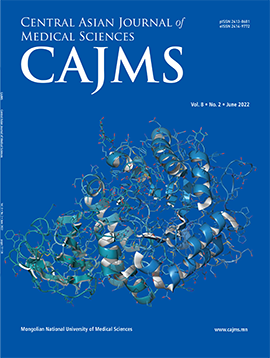Postoperative Subjective and Objective Evaluation of Septoturbinoplasy Surgery in Mongolian Patients with Nasal Obstruction Symptom
DOI:
https://doi.org/10.24079/cajms.2021.12.003Keywords:
Nasal Obstruction, Peak Nasal Inspiratory Flow, Internal Nasal Valve, Septoplasty, TurbinoplastyAbstract
Objectives: The aim of this study was to explore the subjective and objective measurements in assessing before and after nasal septoplasty with and without turbinoplasty surgery. Methods: This was a hospital-based pre and post clinical trial study of 80 patients with nasal septal deviation treated with nasal septoplasty with or without turbinoplasty in 2019- 2020. Nasal patency was recorded subjectively and objectively before and 2.5 months after surgical treatment using a visual analogue scale (VAS), nasal obstruction symptom evaluation (NOSE), sino-nasal outcome test (SNOT-23) questionnaires, peak nasal inspiratory flow (PNIF) measure and internal nasal valve (INV) grading. Results: Nasal septoplasty (38 patients) and septoplasty with turbinoplasty (42 patients) were performed on 80 patients (60 males; 20 females) with a mean age of 37.5 years. The results showed a significant improvement of nasal passage condition in scales of VAS, NOSE, SNOT-23, as well as INV grading, and PNIF values after surgery. Septoplasty with turbinoplasty showed greater improvement in VAS and PNIF scores than septoplasty alone and this was even more significant for bilateral PNIF scores. Conclusion: We found VAS, NOSE, INV grading and PNIF measures to be reliable instruments in reporting results of surgery.
46
Downloads
Published
How to Cite
Issue
Section
License
Copyright (c) 2021 Mongolian National University of Medical Sciences

This work is licensed under a Creative Commons Attribution-NonCommercial 4.0 International License.




